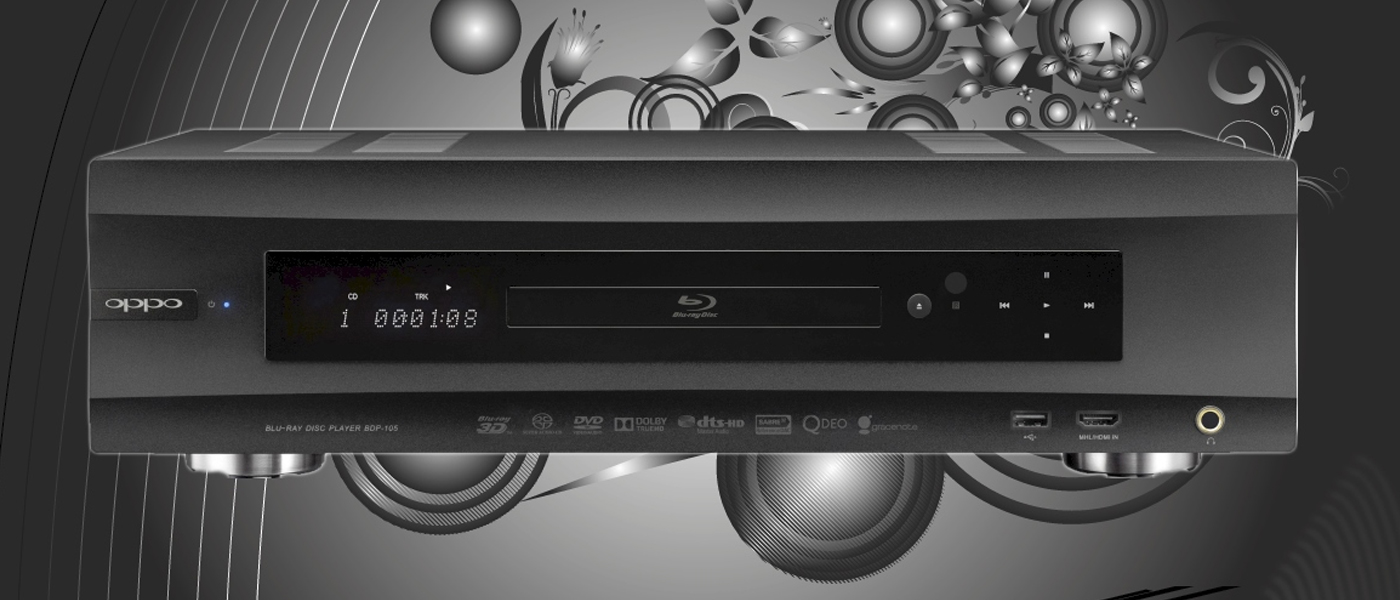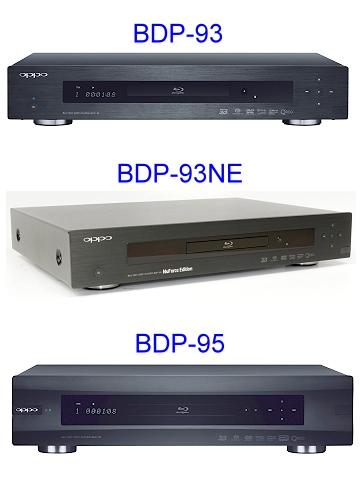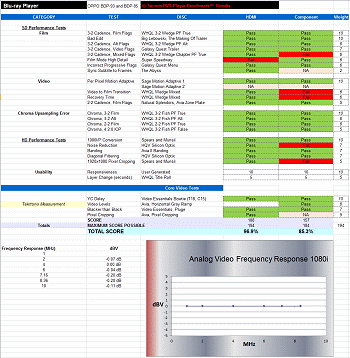Introduction
OPPO has just released its first universal 3D Blu-ray player, the BDP-93, and will shortly release the BDP-95, which adds a pair of balanced outputs (having their own dedicated DACs). At the same time, NuForce has released two upgrade boards that the consumer can install in a BDP-93 player, or purchase the player direct from NuForce with the card installed (Called the BDP-93NE and BDP-93NXE). The review will cover the audio performance of the three players (only the BDP-93NE, not the BDP-93NXE), as well as the video performence using our Benchmark tests. As you will see, OPPO has overturned price/performance expectations, and especially the BDP-95 is reference quality for less than $1,000.
Specifications
- Design: Univeral Blu-ray 3D Player (Highlighted Specifications are for BDP-95 Only)
- Codecs: DVD, Blu-ray, Blu-ray 3D, DD, Dolby TrueHD, DTS-HD Master Audio, DVD-A, SACD, Netflix Instant Streaming, Blockbuster On-Demand, BD-Live
- DACs: The BDP-93 uses a Cirrus CS4382A DAC, and the BPD-95 uses two SABRE32 ES9018 32 Bit DAC’s
- Connections: 2 HDMI, Coaxial Digital Out, Toslink Digital Out, Component Video Out, 7.1 RCA Analog Out, Stereo XLR and RCA Analog Out, Ethernet Port and Wireless N, USB, e-SATA, IR, RS-232
- MFR: 20 Hz – 96 kHz, ± 2 dB; ± 1 dB
- THD+N: 0.002%; 0.0003%
- Internal Storage: 2 GB
- Video Processing: Qdeo by Marvell
- Dimensions: 3.1″ H x 16.9″ W x 12.3″ D; 4″ H x 16.9″ W x 12.3″ D
- Weight: 10.8 Pounds; 16 Pounds
- MSRP: $499 BDP-93; $899 BDP-93NE, $400 for Card by Itself; $999 USA
- OPPO
- NuForce
The Design
The basic features of both the BDP-93 and BDP-95 are similar, except for the DAC’s (the BDP-93 uses the Cirrus CS4382A, while the BDP-95 uses the SABRE32), but also the BDP-95 uses upgraded parts, and adds a dedicated DAC to deliver true balanced output for stereo audio listening (a second DAC handles 7.1 output). On the BDP-93, you use the front left and right RCA output jacks for stereo.
NuForce’s BDP-93NE replaces one board in the chassis. Its performance characteristics include an upgraded power supply, a redesigned output stage that bypasses the muting circuit, different analog filters, and upgraded op-amps. If you already have a BDP-93, you can purchase just the board ($400) and install it yourself, or purchase the player with the card already installed ($899). The BDP-93NXE (not reviewed here because the product was not available for me to test) has a different clocking technology to reduce the jitter in the bitstream (3 pico-seconds). The BDP-93NXE will be available as either a card ($800) that you can install in your existing BDP-93, or as the player with the card already installed ($1,299).
The BDP-95 is more than five pounds heavier than the BDP-93, and undoubtedly, some of this weight is in the power supply and shielding.
The first photo below shows the rear panel of the BDP-93, the second photo is the BDP-93NE, and the third photo shows the BDP-95 (click on the photos to see the large version). You can see that externally, the BDP-93 and BDP-93NE are the same, and that is because only a PC board inside the chassis has been changed. On the front panel, the BDP-93NE has the NuForce logo.
Note that all the players have an Ethernet port, but also contain wireless N so the player can communicate with your home network to download firmware updates. The players also have two HDMI jacks, so you can connect one HDMI jack directly to a 3D HDTV and the other to the HDMI input jack on your receiver, if your receiver does not support Blu-ray 3D.
If you don’t have a wireless network, or the distance from the player to your Internet router is too far, the OPPO’s have a USB 2.0 jack that will let you update firmware by downloading it from the OPPO website, copying it onto a memory thumb drive, inserting it into the USB jack on the OPPP, which the OPPO will then recognize and automatically update the firmware.
RS-232 an IR ports allow for remote control.
Speaking of which, the remote control for the new OPPO’s is the same as for their previous players, such as the BDP-83. It’s one of the easiest to use remotes out there. No need to change it.
In Use (JEJ)
Because the BDP-93, BDP-93NE, and BDP-95 bench tested so well out of the analog audio jacks, I watched movies with the video through the HDMI output, but the audio through the 7.1 analog output jacks. I also listened to music using the analog connections rather than HDMI, which has significant jitter issues. I used an Anthem D2 as the processor, which has a pair of XLR balanced inputs for the stereo analog audio listening as well as 5.1 analog RCA input jacks, Denon AVP-A1HDCI processor with 7.1 RCA analog inputs, Lamm LL1 stereo preamplifier (two-channel RCA out), Balanced Audio VK-5i preamplifier (two-channel XLR out), Classé CA-5200 multi-channel power amplifier, McIntosh MC1201 monoblock power amplifiers, Lamm M2.2 monoblock power amplifiers, Carver Mark IV ribbon speakers, and a Paradigm Reference Signature C5 center channel speaker. Cables were Emotiva, Marc Audio, and Legenburg.
Machete was an odd movie – sort of Tarrantino-esque – with Danny Trejo as the hero, and Robert De Niro as the bad guy. Notwithstanding that it was not exactly entertaining to see so many heads lopped off by Danny’s machete, the sound quality was terrific. Just when I thought it was safe to put all those RCA interconnects away, you know, the ones used to connect the multi-channel analog outputs from the DVD player to the multi-channel analog audio inputs on the receiver, out they came, because the DACs in the players are better than the ones in the SSP.

The American is a current Blu-ray release, and I watched it for the first time on the BDP-95. The sound was perfect.

High resolution multi-channel music is starting to appear in Blu-ray format. I love Baroque music, and this Blu-ray release using DTS-HD Master Audio was marvelous. To hear the delicacies of stringed instruments in chamber music requires low distortion and low noise, both of which are characteristics of the BDP-93, BDP-93NE, and BDP-95.

This DVD-A release of Holst’s The Planets was terrific in surround and high resolution. “Mars – The Bringer of War” is my favorite of the tracks, and it was thunderous, yet clear in every nuance.

SACD is alive and well, and I thoroughly enjoyed this Telarc recording of Liszt compositions in multi-channel surround. No harshness, no midrange mush, no excessive sibilance. Just satin smooth musical pleasure.

I also listened to many of my favorite CDs, using the stereo XLR outputs from the BDP-95, and I have never heard a better quality sound. The noise and distortion characteristics of the BDP-93 and BDP-95 are so low, frankly, I could not hear a difference between the two players, but others, with younger ears than mine, probably would be able to detect, perhaps, slightly better detail using the BDP-95. Also, if your other components have medium levels of distortion, it would be best to have the source with as low distortion as possible, so that it does not push the total amount of system distortion into a range that is really noticeable.
With the 93NE, its predominance of even ordered distortion compared to the odd ordered distortion of the 93 made it sound a bit more musical, sort of like what a Class A triode does (almost entirely second order distortion). It was a slight difference, but I could hear it (triodes produce large second order peaks, while the second order peaks in the 93NE were small). When I asked NuForce about this, they said that the emphasis on second order harmonic distortion was their exact intent, and that the result would be “more musical”.
On the Bench
Video (Chris Heinonen and Stephen Hornbrook)
Both the BDP-93 and BDP-95 players measured identically on the video bench, which was to be expected as they have different analog audio boards but the same video boards. As you look over the results you can see that the HDMI performance of the players was fantastic. The only issue with video came with the original Super Speedway DVD clips, which kept dropping and relocking the cadence during the clip. The HD versions of the clip ran through perfectly on all cadences. The only other clip that presented any issues to the OPPO players was the ending credits of the original Austin Powers DVD, which has mixed film and video sections. Here, it once again dropped and relocked on the film cadence multiple times, while the video credits rolled by correctly. The Blu-ray of Austin Powers was 24p and presented none of these issues over HDMI.
With component there were a few more issues, which OPPO was very happy to discuss with us. In most cases, it wasn’t a matter of being able to de-interlace a certain cadence correctly, but that the time to lock onto this cadence was longer than we demand of players. OPPO also said when given the choice between HDMI or Component performance for the players, they chose HDMI, which I imagine is the choice we all would prefer.
On the pixel cropping tests, a single pixel was cropped both at the right and bottom of the image, which will probably not be noticed, but led to a fail on that test. In the noise reduction test, while this was perfect over HDMI, over component the chipset could only reduce block noise and random noise, but not mosquito noise, leading to the fail score. Finally, on one of the wedge patterns from Digital Video Essentials Pro, the OPPO never correctly de-interlaced the horizontal moving wedge, but over HDMI, it did it instantly. The video levels over component video were strong as well, with a full 100 IRE output at peak white and very little drop-off on the multiburst resolution tests. The OPPO is a truly fantastic player for video and will likely be the new reference player for people going forward.
Audio (JEJ)
What I will do here is show comparative graphs from the BDP-93, BDP-93NE, and BDP-95 arranged together. This will allow you to see how the three players performed compared to one another without having to scroll farther down the page to see the second or third graph of a test applied to all three players. So, for any particular test, the graph for the BDP-93 will be first, followed by the BDP-93NE, and then the graph for the BDP-95.
Let’s start with standard Redbook CD tests. At 1 kHz, the 93 had 0.013% THD+N, and the 93NE had 0.009%, while the 95 – in the third graph using the RCA output rather than the balanced output – had 0.004% distortion. The fourth graph is the 95 using the balanced XLR output, and all subsequent graphs for the 95 also use the XLR output. Distortion was the same as with the RCA unbalanced output: 0.004%. However, the XLR output delivered twice the voltage. What this means is that you will be able to turn the volume control down, and this will result in less overall noise. Some preamplifiers with true balanced inputs take into account the increased voltage at the XLR input so that you don’t have to change the volume control when switching between the XLR inputs and another source which might be connected to RCA inputs, however, you will still have less noise with the XLR input.
Compare the 93 with the 93NE and you will see that the 93 has third and fifth order (odd ordered) distortion peaks, while the 93NE only has a second order (even ordered) peak. The change from odd ordered to even ordered distortion is part of what you get for the additional $400 in the 93NE.
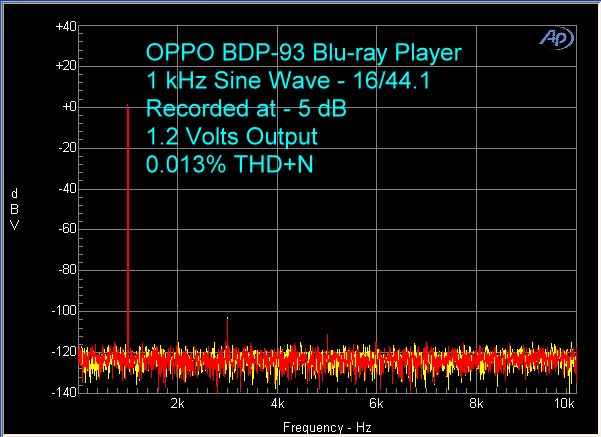
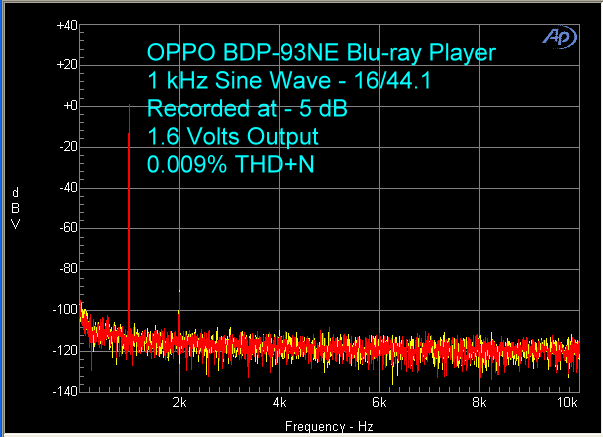
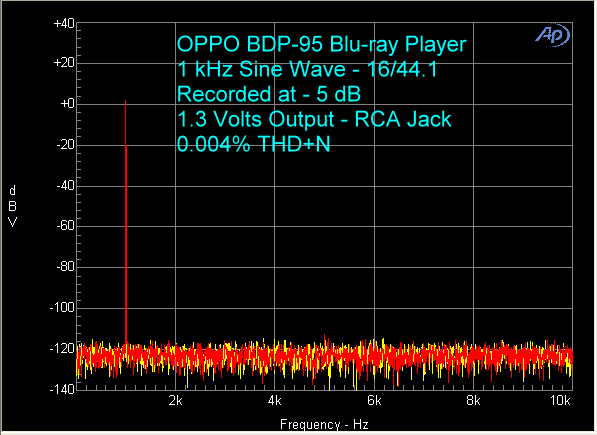
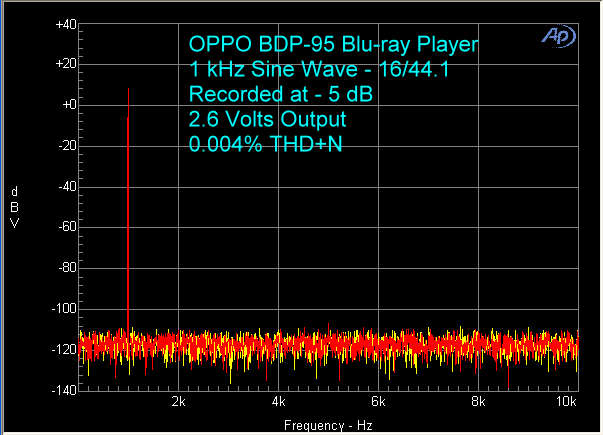
Using 19 kHz and 20 kHz test signals, there was no visible B-A peak at 1 kHz with either player. There was a small 1 kHz peak with the 93NE. Side bands to the fundamentals were minimal with the 93, none with the 93NE (although there were higher peaks in the out of audible band region), and also none with the 95.
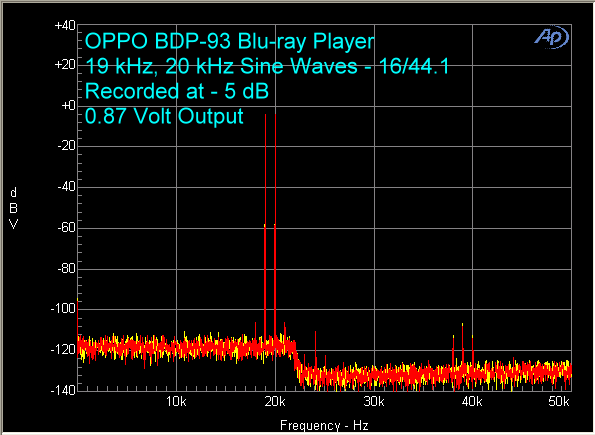
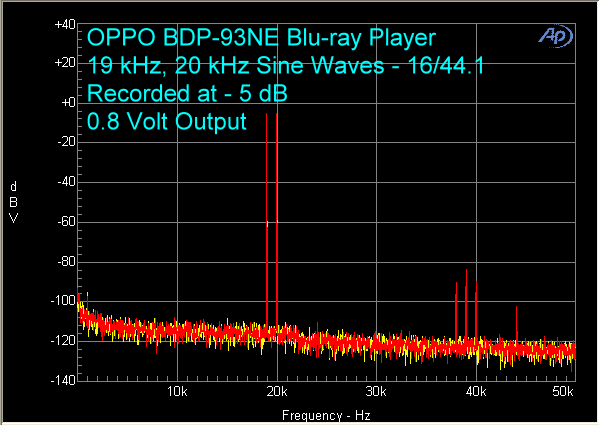
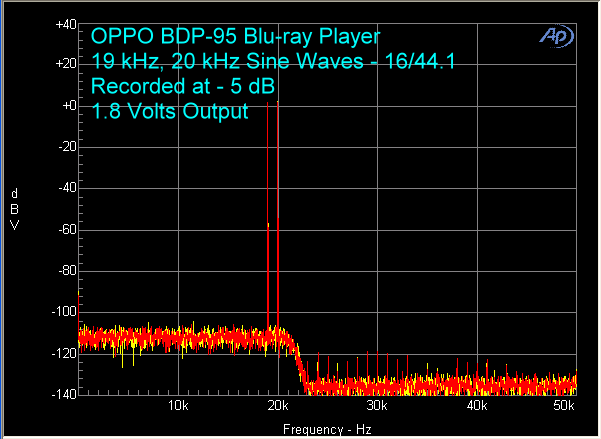
The IMD measurement used 60 Hz and 7 kHz sine waves at a 4:1 ratio (SMPTE standard). All three players had very low IMD, and I would consider the difference insignificant. Although the 93NE had a higher IMD number, there appear to be less peaks at the base of the 7 kHz input signal, and this is why it is so important to show both the numerical calculation as well as the graph, rather than simply the number. (Note that I mistakenly used the 60 Hz – 2 kHz track from my test disc for the 93 measurement, which I will correct when I get the 93 back after the video testing is completed by Chris Heinonen. I used to test IMD with 60 Hz – 2 kHz, but recently converted to the 60 Hz – 7 kHz SMPTE standard. Both tests give pretty much the same results, but one can see the side peaks easier at 2 kHz. However, 60 Hz – 7 kHz is the standard, so I decided to switch over to that test. In any case, none of the players had significant IMD at 16/44.1.)

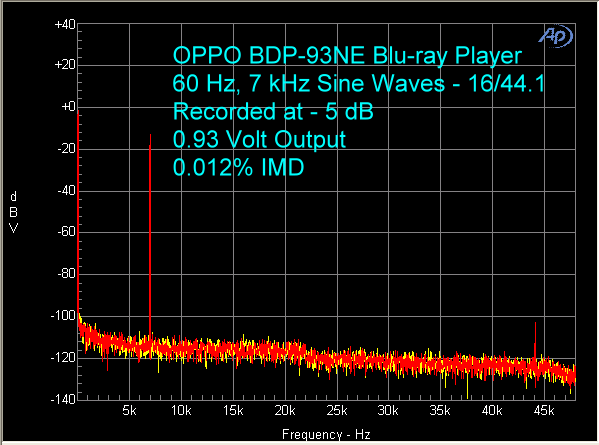
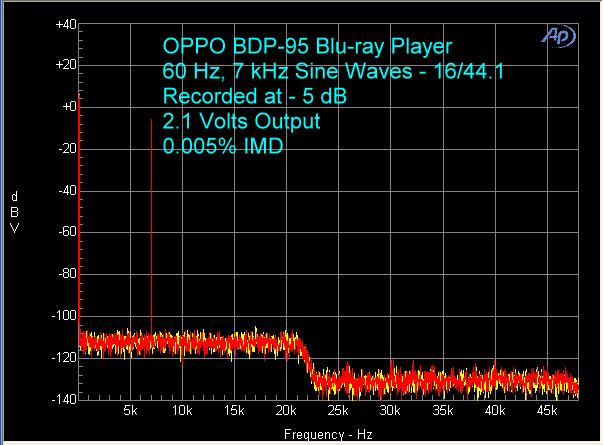
The measured frequency response was within ± 0.02 dB, 20 Hz – 20 kHz, for the 93, with a slight rise above 15 kHz. The response of the 93NE rolled off a little more than 1 dB at 20 Hz and was down 0.3 dB at 20 kHz. This may seem like a poor frequency response, but it was part of the 93NE design, which apparently reduces distortion, and having a rolloff of 1 dB is, in fact, not very much. We are all just so used to seeing a response that is within 0.1 dB, the 1 dB rolloff seems like a lot. The 95’s response was – 0.18 dB at 20 kHz.

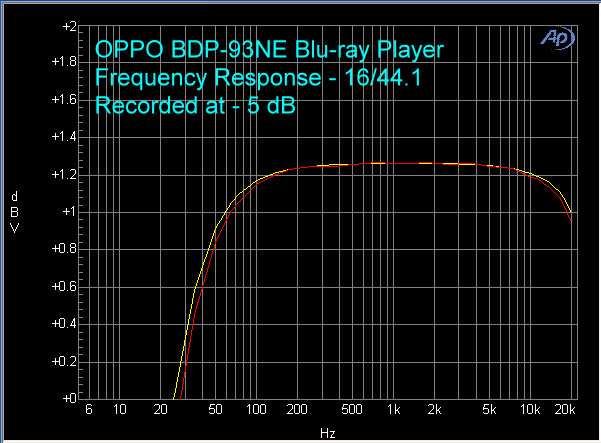
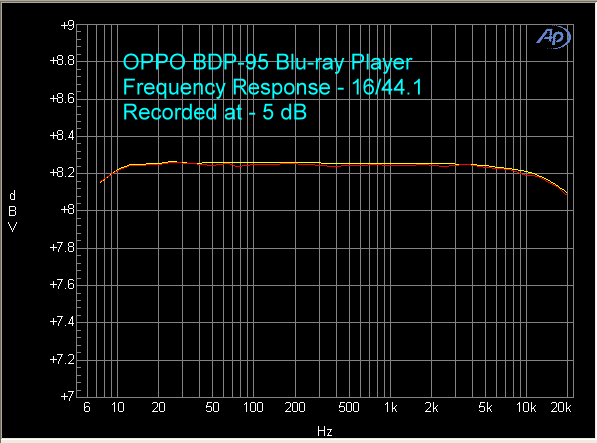
Let’s now move on to DVD-A. Downloadable high rez PCM music at 24/192 is starting to appear, so I will just cut to the chase and show data at the highest sampling rate of 24/192.
First, let’s look at the 93 tested with a 1 kHz sine wave input signal. Distortion was 0.007%. For the 93NE, there were less distortion peaks, but a bit more noise at the lower frequencies, which resulted in a higher number because it includes noise (THD+N). Graph number three is the 95, and distortion was 0.0004%. You read that number right. Four ten thousandths of 1 percent. Plus, the advantage of twice the output voltage due to being fully balanced.
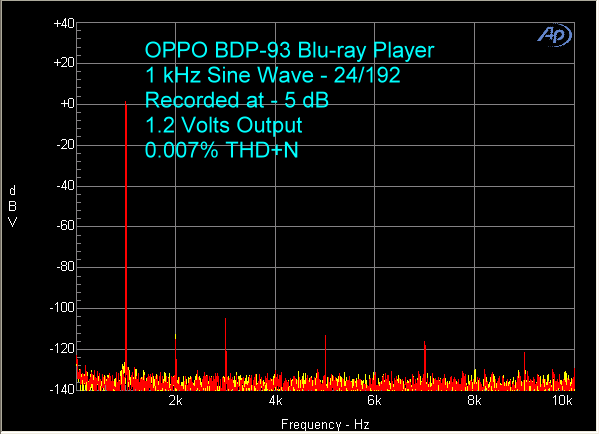
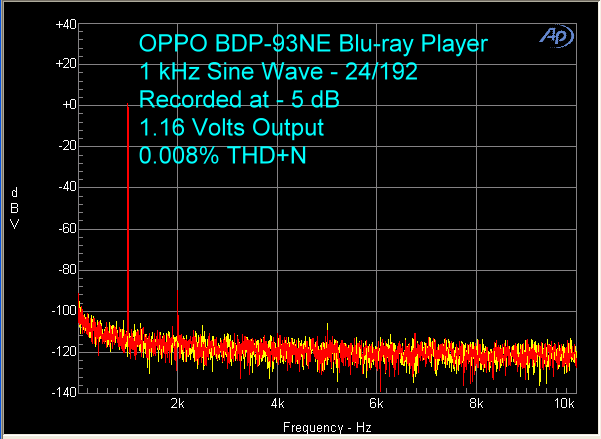
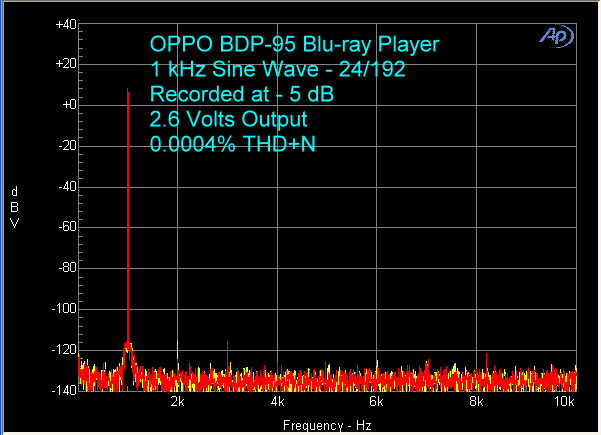
Using 19 kHz and 20 kHz, the B-A peak at 1 kHz is at about 120 dB below 0 dBFS for the 93 and 95, but 90 dB below 0 DBFS for the 93NE. However, note that with the 93NE, there are no side peaks around the 19 kHz and 20 kHz fundamentals, while there are noticeable side peaks with the 93 and 95.
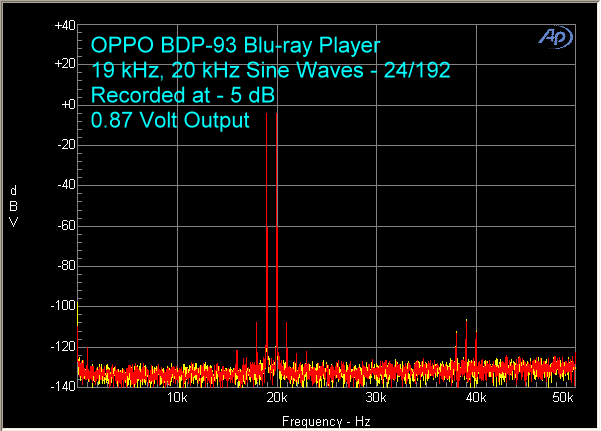
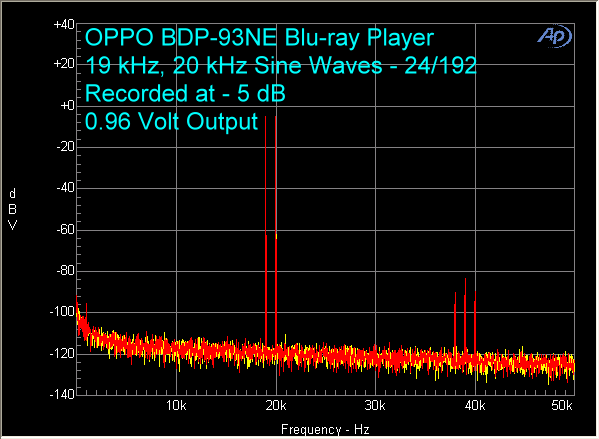
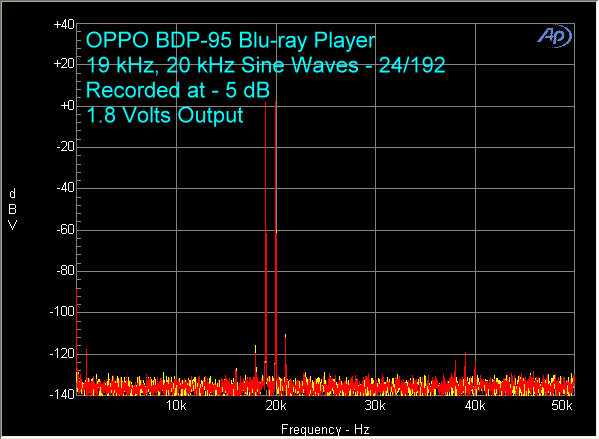
Want another surprising result. IMD for the 93 was 0.006% – and keep in mind this is a $499 player – while in the 95, it was 0.0006%. The 93NE’s number reflects a somewhat more noise, and any peaks that might have been there are below the noise level. Hey guys, the test results are beginning to reach the limits of detectability for my $26,000 Audio Precision. At $999 for the BDP-95, I cannot come up with an adjective to describe the performance/value this product represents. And the BDP-93 is no slouch, at $499.
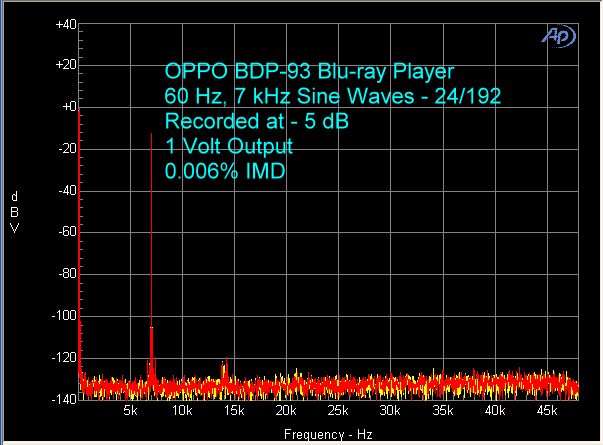
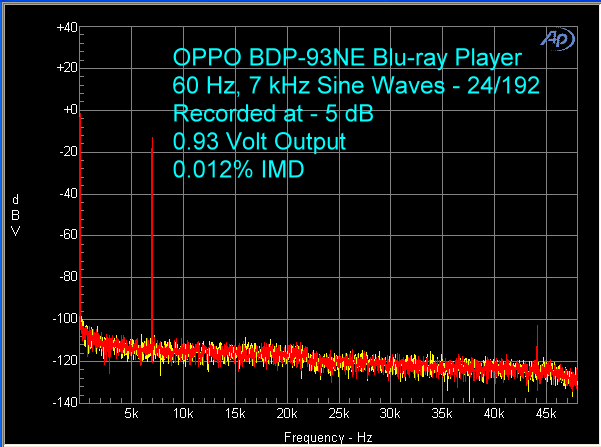

The measured frequency response for the BDP-93, using a sweep recorded at 24/192 sampling, was flat out to 10 kHz, then a rise of 0.04 dB to 30 kHz, before declining to being down 1 dB at 80 kHz. For the BDP-93NE, the response rolled off just as it did at 16/44.1 sampling, and was down 1 dB at 30 kHz. The BDP-95 had a completely different response spectrum, flat to 5 kHz, then a slow roll-off of 0.1 dB at 20 kHz, and down 1 dB at 75 kHz.
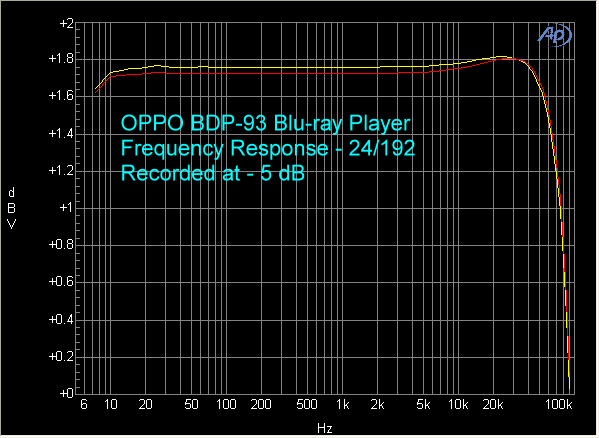
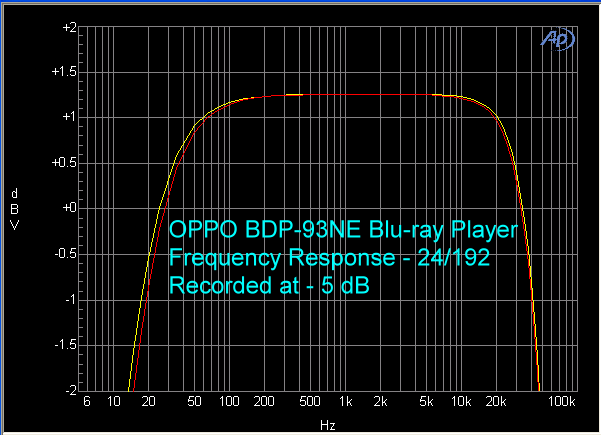

Now for SACD performance.
At 1 kHz, the BDP-93 produced 0.017% THD+N, while the BDP-95 had none. That’s right. None, at least nothing that the Audio Precision could detect. Even though there are some peaks, the output voltage is high enough and the peaks lower than the input signals enough that the Audio Precision could not detect distortion at the 0.0000% level. The BDP-93NE had 0.014% IMD, but the predominant peak was second order, while with the BDP-93, there were noticeable fifth and seventh order peaks.
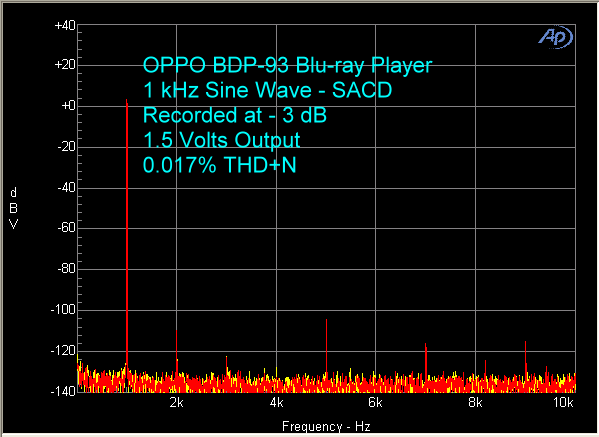
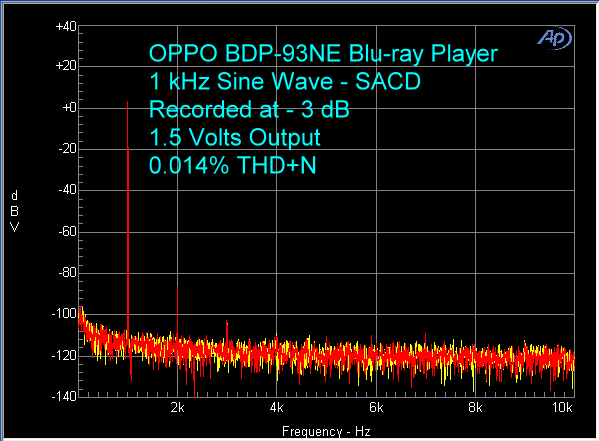
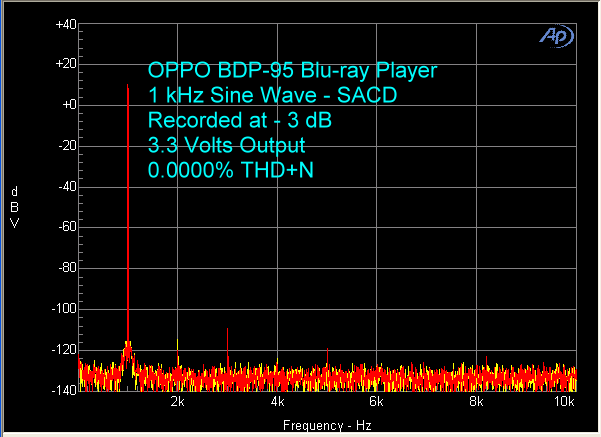
With 19 kHz and 20 kHz test signal, the B-A peak for the BDP-93 was 110 dB below the fundamentals, which is excellent. The B-A peak for the BDP-93NE was – 92 dB. However, the 93NE had less side peaks around the 19 kHz and 20 kHz input signals than either the 93 or 95, although the higher noise is partly responsible for this. For the BDP-95, there was no detectable B-A peak.

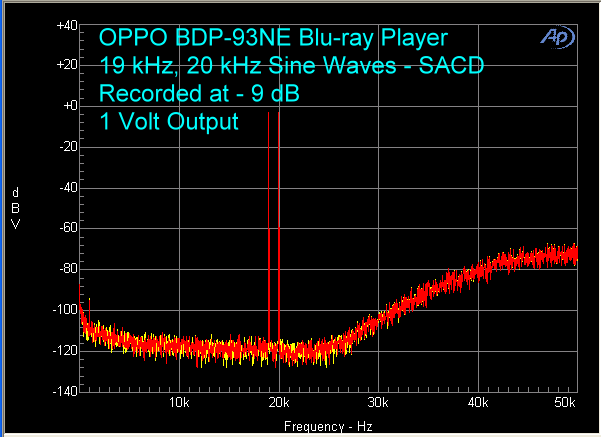
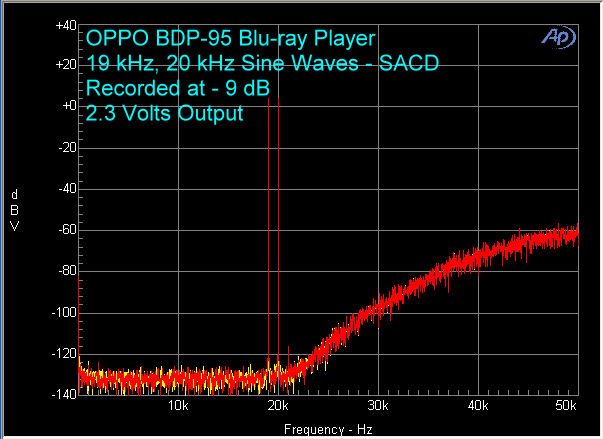
The IMD measurements showed 0.05% for the 93, 0.09% for the 93NE, and 0.12% for the 95. This was the only case where the numbers favored the 93. But if you look at the side peaks next to the 7 kHz fundamental, it appears that the 95 has less. So, the Audio Precision must have been detecting something else that is not readily visible in the spectrum. In any case, the data are good for all three players.
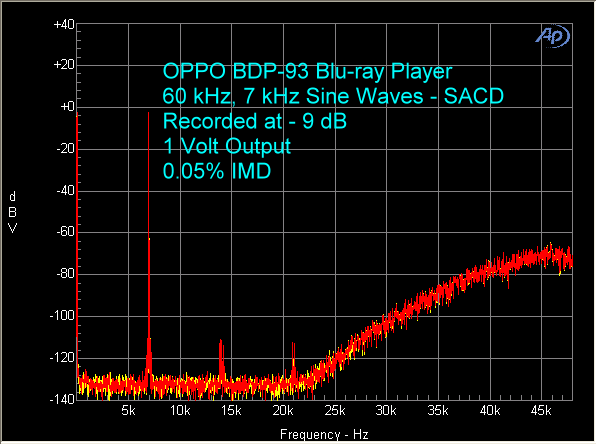

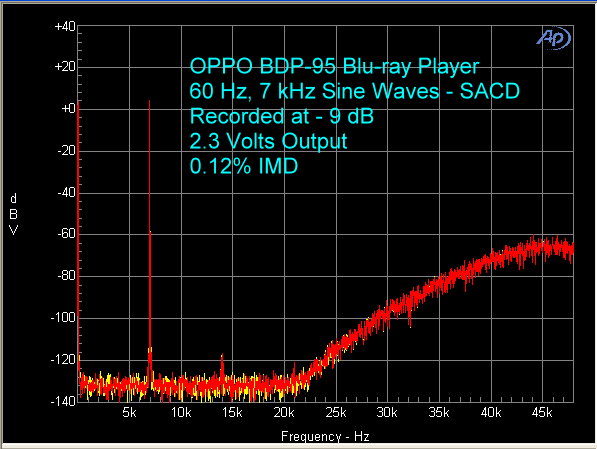
The measured frequency response for the 93 was flat from 20 Hz to 20 kHz, then a slight rise of 0.05 dB at 30 kHz, then a rapid decline. The response was down 1 dB at 43 kHz. The now familiar rolloff for the 93NE was present in the SACD test. For the 95, the measured response started rolling off at 3 kHz to be down 0.1 dB at 20 kHz, and down 1 dB at 38 kHz.
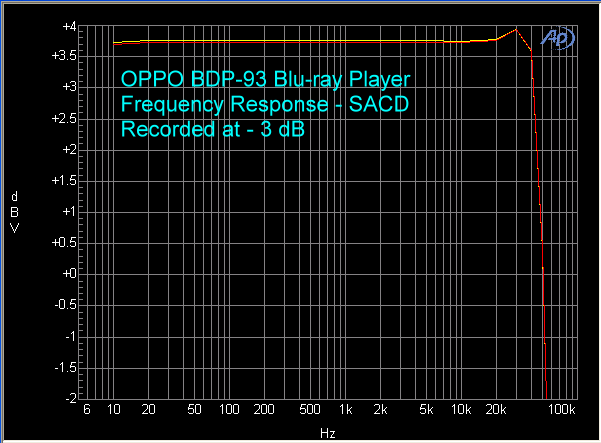
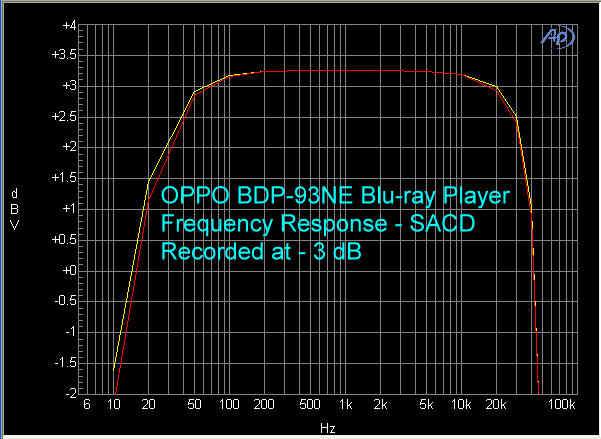
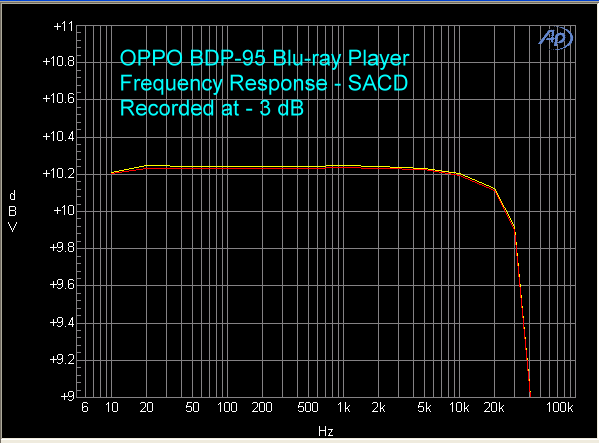
Jitter for the 93 and 95 was essentially identical (I didn’t measure it in the 93NE because the transport is not altered in the NuForce edition of the player). The measurement was taken from the coaxial digital output, using a CD containing an 11 kHz sine wave as the test signal. This test measures jitter in the digital bitstream, in the digital domain, as compared to other types of measurements using the analog output signal and deducing the amount of jitter from the resulting spectrum. Jitter averaged about 5-10 pico-seconds when the signal was playing, with 17 major peaks, the largest of which was 900 pico-seconds. These are very good results.
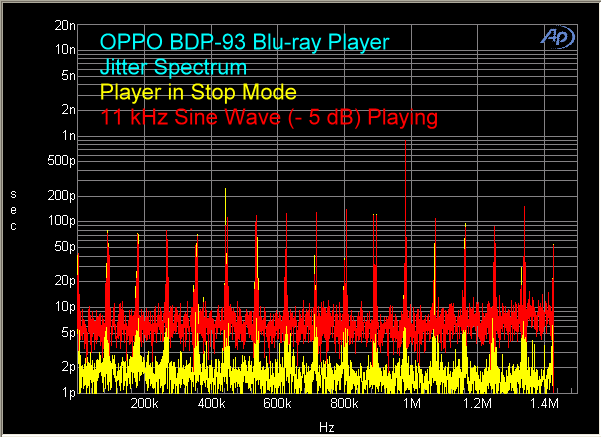

Conclusions
Both the OPPO BDP-93 and BDP-95 represent two of the very best Universal Blu-ray players on the market, and especially the BDP-95’s audio performance is nothing short of superb, posting some audio measurements that were below the limits of detectability by the standard bench test instrument in the industry. The OPPO’s video performance is also excellent. In short, the BDP-95 is a reference quality player, capable of standing toe-to-toe with the best projectors, SSPs, preamps, power amps, and speakers out there. The BDP-93NE does show some measureable audio performance differences from the basic 93 and offers the consumer another choice, where different factors are emphasized.


